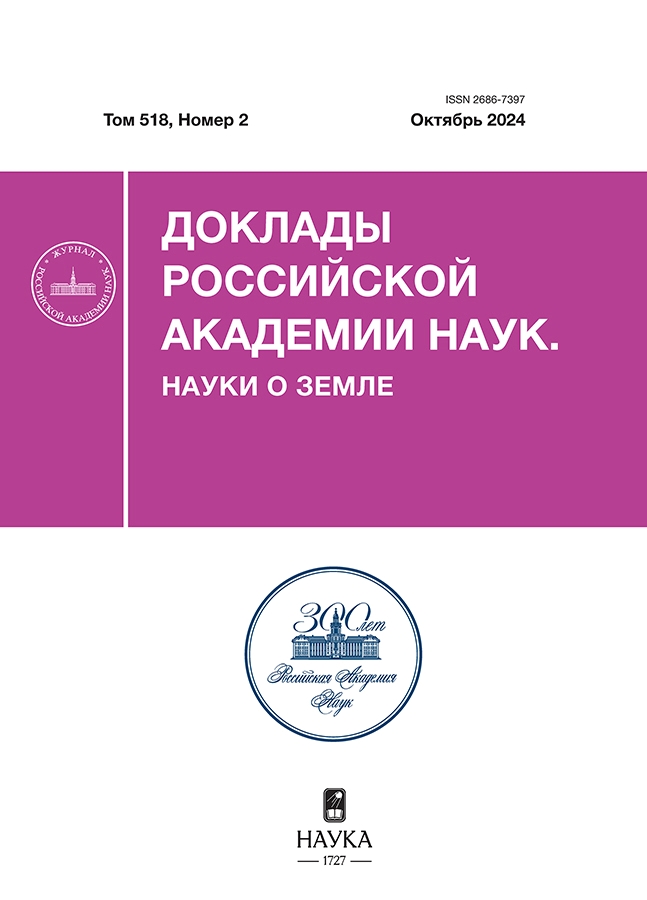Age and Volcanic History of the Dariganga Volcanic Field (SE Mongolia)
- Autores: Yarmolyuk V.V.1, Kozlovsky A.M.1, Savatenkov V.M.2, Kudryashova E.A.1
-
Afiliações:
- Institute of Geology of Ore Deposits, Petrography, Mineralogy and Geochemistry of the Russian Academy of Sciences
- Institute of Precambrian Geology and Geochronology of the Russian Academy of Sciences
- Edição: Volume 518, Nº 2 (2024)
- Páginas: 222-230
- Seção: GEOLOGY
- ##submission.dateSubmitted##: 31.01.2025
- ##submission.datePublished##: 15.12.2024
- URL: https://gynecology.orscience.ru/2686-7397/article/view/649901
- DOI: https://doi.org/10.31857/S2686739724100033
- ID: 649901
Citar
Texto integral
Resumo
The results of systematic K–Ar geochronological studies are presented for the rocks of the Late Cenozoic basaltic Dariganga Volcanic Field (DVF). Four stages of its volcanic history have been identified: Middle-Late Miocene (>10 Ma), Late Miocene-Early Pliocene (7.8–3.5 Ma), Late Pliocene (2.8–2.6 Ma) and Pleistocene (<1.7 Ma). The volcanic products of each stage were suitably distributed over the area of the volcanic field. The main volume of volcanics was erupted during the Late Miocene–Early Pliocene and the Pleistocene. During the Late Miocene–Early Pliocene, the northwestern part of the lava field was formed, which has a lava plateau morphology. Eruption centres were located within structural depressions that developed during extension and accompanied volcanism. The south-eastern part of the DVF was formed during the Pleistocene. Volcanism occurred simultaneously with the uplift of the Khukhot-Ein-Nuruu ridge within the Nukut-Daban highland, which influenced the morphology of the volcanic cover. This volcanic stage is characterised by large multi-centre shield volcanoes localised in the axial zone of the ridge, and extensive valley lava flows spreading down both slopes of the ridge. The volcanic history of the DVF and other volcanic areas of the Late Cenozoic intraplate volcanic province of Central and East Asia are compared. They developed in concert with each other, so the formation of the DVF being initiated by the same geodynamic mechanisms as the other volcanic areas of the province, namely the activity of a small mantle plume.
Palavras-chave
Texto integral
Sobre autores
V. Yarmolyuk
Institute of Geology of Ore Deposits, Petrography, Mineralogy and Geochemistry of the Russian Academy of Sciences
Email: amk@igem.ru
Academician of the RAS
Rússia, MoscowA. Kozlovsky
Institute of Geology of Ore Deposits, Petrography, Mineralogy and Geochemistry of the Russian Academy of Sciences
Autor responsável pela correspondência
Email: amk@igem.ru
Rússia, Moscow
V. Savatenkov
Institute of Precambrian Geology and Geochronology of the Russian Academy of Sciences
Email: amk@igem.ru
Rússia, Saint Petersburg
E. Kudryashova
Institute of Geology of Ore Deposits, Petrography, Mineralogy and Geochemistry of the Russian Academy of Sciences
Email: amk@igem.ru
Rússia, Moscow
Bibliografia
- Влодавец В. И. О некоторых чертах кайнозойского вулканизма Даригангской области Монголии// Вопросы геологии Азии. М.: Издательство АН СССР, 1955. Т. 2. С. 679–685.
- Кепежинскас В. В. Кайнозойские щелочные базальтоиды Монголии и их глубинные включения. М.: Наука, 1979. 312 с.
- Кононова В. А., Иваненко В. В., Карпенко М. И., Аракелянц М. М., Андреева Е. Д., Первов В. А. Новые данные о К–Аr-возрасте кайнозойских континентальных базальтов Байкальской рифтовой системы // Доклады АН СССР. 1988. Т. 303. № 2. С. 454–457.
- Корина Н. А., Певзнер М. А., Чичагов В. П. Палеомагнитные исследования вулканической области Дариганга в юго–восточной Монголии. В кн.: Палеомагнитный анализ при изучении четвертичных отложений и вулканитов. М.: Наука, 1973.
- Салтыковский А. Я., Геншафт Ю. С. Геодинамика кайнозойского вулканизма юго-востока Монголии. М.: Наука, 1985. 135 с.
- Ступак Ф. М., Кудряшова Е. А., Ярмолюк В. В. Позднекайнозойский вулканизм Витимской впадины и его связь с Витимским лавовым плато (Западное Забайкалье) по данным геохронологических K–Ar-исследований // Доклады РАН. 2018. Т. 482. № 4. C. 429–433.
- Чернышев И. В., Лебедев В. А., Аракелянц М. М. K–Ar датирование четвертичных вулканитов: методология и интерпретация результатов // Петрология. 2006. Т. 14. С. 69–89.
- Ярмолюк В. В., Саватенков В. М., Козловский А. М., Ступак Ф. М., Кузнецов М. В., Шпакович Л. В. Условия формирования пород и источники магм позднекайнозойского Удоканского вулканического плато // Петрология. 2023. Т. 31. № 1. С. 3–28.
- Ярмолюк В. В., Кудряшова Е. А., Козловский А. М., Саватенков В. М. Позднекайнозойская вулканическая провинция Центральной и Восточной Азии // Петрология. 2011. Т. 19. № 4. С. 341–362.
- Ярмолюк В. В., Кузьмин М. И. Корреляция эндогенных событий и вариации климата в позднем кайнозое Центральной Азии // Стратиграфия. Геологическая корреляция. 2006. Т. 14. № 2. С. 3–25.
- Chuvashova I. S., Rasskazov S. V., Yasnygina Т. А., Mikheeva Е. А. High–Mg lavas from the Dariganga volcanic field in the South-Eastern Mongolia: petrogenetic model of magmatism at the asthenosphere–lithosphere boundary // Geodynamics & Tectonophysics. 2012. V. 3(4). P. 385–407.
- Ho K.-S., Liu Y., Chen Ju-Ch., Yang H.-J. Elemental and Sr–Nd–Pb isotopic compositions of Late Cenozoic Abaga basalts, Inner Mongolia: Implications for petrogenesis and mantle process // Geochem. J. 2008. V. 42(4). Р. 339–357.
- Sun S.-S., MсDonough W. F. Chemical and isotopic systematics of oceanic basalts: implications for mantle composition and processes. In: A.D. Saunders and M.J. Norry (Eds.) Magmatism in the Ocean Basins. London: Geological Society (Special Publications), 1989. V. 42. P. 313–345.
- Thordarson Th., Höskuldsson Á. Postglacial volcanism in Iceland // JÖKULL. 2008. № 58. 199 p.
- Togtokh Kh., Miao L., Zhang F., Baatar M., Anaad Ch., Bars A. Major, trace element, and Sr–Nd isotopic geochemistry of Cenozoic basalts in Central–North and East Mongolia: Petrogenesis and tectonic implication // Geol. J. 2019. V. 54. P. 3660–3680.
- Wang Sh.-P., Ren Zh.-Y., Nichols A.R.L., Narantsetseg T., Zhang Q.-L., Zhang L., Yuan Ch. Cenozoic mantle plume activity in East Asia: Constraints from geochemistry of olivine, spinel, and melt inclusions // Lithos. 2023. V. 456–457. P. 456–457.
- Yarmolyuk V. V., Kuzmin M. I., Ernst R. E. Intraplate geodynamics and magmatism in the evolution of the Central Asian Orogenic Belt // J. Asian Earth Sci. 2014. V. 93. P. 158–179.
- Zhang M., Guo Z. Origin of Late Cenozoic Abaga–Dalinuoer basalts, eastern China: Implications for a mixed pyroxenite–peridotite source related with deep subduction of the Pacific slab // Gondw. Res. 2016. V. 37. P. 130–151.
Arquivos suplementares













